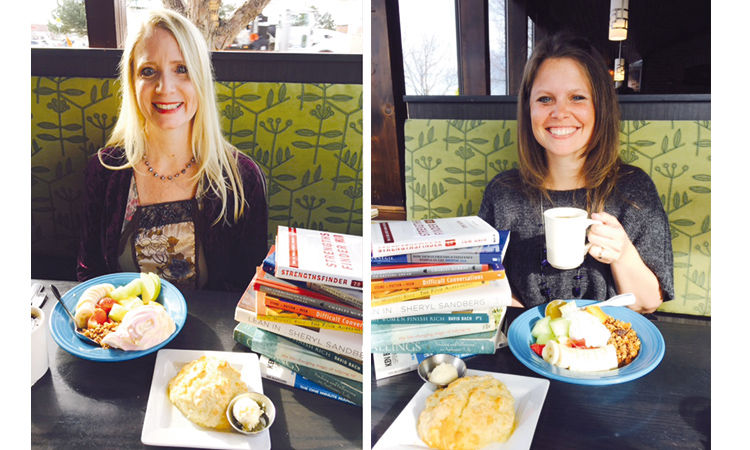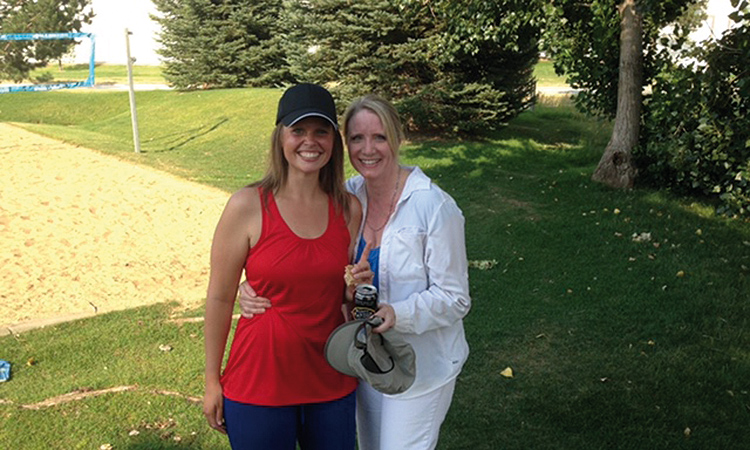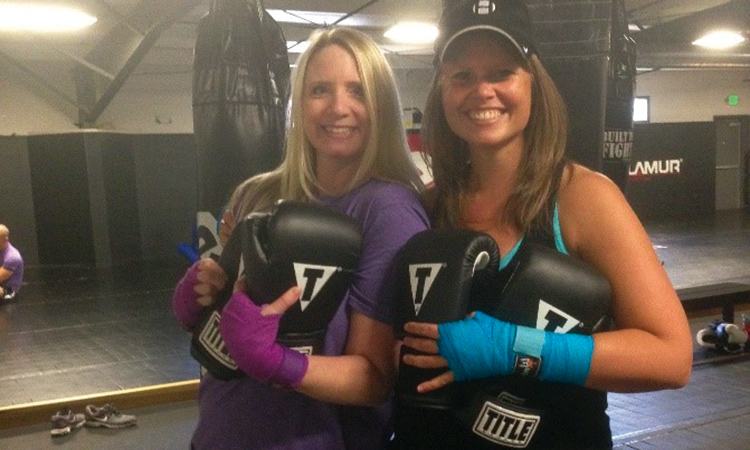Gen X, Millennial - The Mentoring Relationship, Step by Step

Mentoring is a hot topic these days. Do a quick Google search of the word “mentoring” and you’ll get some 95 million results. A narrower search, “mentoring an engineer,” will get you about 11 million results, or 12% of the first search. For even more targeted results, try searching “mentoring a woman engineer,” which returns 438,000 results—about 0.5% of the results for mentoring. And how many of those 438,000 results are relevant? Every article offers similar messages: It’s important to mentor the younger generation; young engineers need mentoring to succeed. How does this mentorship play out? And how does one become a mentor or mentee?
What follows is a case study of a mentoring relationship between GenXer* Kerren Bergman and Millennial* Kelly Scalva. The study includes examples of reading materials, topics of guidance, lessons learned, and the joint successes both the mentor and mentee have seen in both their personal and professional lives.

Gen X Steps
Kerren Bergman
I have noticed that as I age, I get more set in my ways. If you’re like me, in your late 40s with 25 years or so of work history, you probably find it easier to do things as you’ve been trained to do. You rely on knowledge gained from years of experience.
But experience can cage us in. Young people hold a key that can set us free, and mentoring them is a great way to obtain that key. For those of you who think mentoring is a burden, I can guarantee that you will receive far more than you give.
STEP 1: MAKING A CHOICE
We Gen Xers are proud to recall how things were “back then”:
- We started working before the internet, email, cell phones, or Google existed.
- Our mail was physically delivered to us daily in interoffice envelopes.
- Our tools were typewriters, transcription machines, Encyclopedia Britannica, and card catalogues.
- Hard-copy calendars and day planners captured meetings, notes, and to do lists, and we carried them with us everywhere.
Think of how much technology has changed throughout our careers! Beyond their ability to embrace new technologies, young people today have open minds, unending curiosity, and desire for information. They want to contribute, and will carry you forward with their spirit.
You have a choice: You can be a rock in the river and let all this change flow around you, or you can let go and experience an amazing new world. Your mentee will accompany you—and it’s so much more fun navigating together.
STEP 2: WHERE TO BEGIN?
If you’re asked to be a mentor, and if you think there’s a connection between you and that person, say yes! If you’re not asked, but have a desire to mentor, identify a high-potential performer in your organization with whom you may have a connection, and make the commitment.
Why would you venture down this path? Because it will inspire your own personal and professional growth. Your mentee will keep you aware of the fabulous tools that just keep on coming. You will make a deep connection with another human being that may last a lifetime. You will strengthen your organization, improve communication, and increase employee retention.
The professional environment continues to evolve. There are still basic ingredients like people, products, and deadlines, but now there are endless variations of communication and potential outcomes. To navigate this landscape, the wisdom of knowing how to interact professionally is essential. Long years of experience teach you the wisdom of knowing an email can be misinterpreted, depending on tone and context, or the wisdom of knowing how to listen to an alternative perspective and collaborating to find a solution. Mentoring will give you the opportunity to pass on that knowledge.
STEP 3: THE MENTORING PROCESS EXAMINED
When you begin the mentoring relationship you will drive the format of your meetings, timing, and content. Given how many people are working remotely these days, you may have to mentor virtually: over the phone, by webinar, Skype, etc. If you have the luxury of working together in the same office (as Kelly and I did), it’s much easier to coordinate meetings, and anything occurring face-to-face is more powerful.
Kelly did not have expectations regarding process, but I decided we should meet biweekly, off-site, to avoid usual office interruptions. I chose one of my favorite restaurants for us to meet, but you could meet at a coffee shop, a library—anywhere that is comfortable for both of you and relatively private. There were many occasions where frustrations were aired and lots of emotions were shared, so it helped to have a quiet space where we could interact.
Our biweekly appointment was “sacred” on my calendar. I realized that if I moved it frequently, I would be sending a message that my meeting with Kelly was not a high priority, when in fact, I cherish our hour together.
I asked Kelly to keep a notebook and told her there would be homework. I also committed to doing homework myself. I’m a “lead by example” manager and never ask anyone who supports me to do something I would not do myself. Kelly took this directive very seriously, and by the time we decided to write this article, she had several notebooks to which we referred. I would assign her homework based on a concept, book, or article we’d read, and she would keep notes and details of her progress. She is a true engineer: methodical, diligent, and dedicated. Her level of commitment is directly reflected in the strides she has made.
Although we met off-site biweekly, our mentoring activity seeped into our daily work life. Kelly would come into my office and excitedly tell me about a success she’d had, based on our recent exercises. Or she would send me an email chain and ask for feedback on her response. There were days she would text me in dismay over an argument, or suggest a walk around the block to process a team meeting. The beauty of this work is that it seeps into your daily moments, whether at work or at home. The growth that you experience is not limited to the work environment. This is why mentoring fundamentally encourages human growth.
STEP 4: PS
The differences among generations can be illustrated by this section’s header. How many young people today know that “PS” stands for “Post-Script?” Does it matter if they don’t? How much do we keep of the “old” and adopt of the “new”? How do you even define either of those categories anymore? In what time frame?
As Kelly states, there is no ending to the growth in a person’s career or personal life. Whether you’re at the beginning of your career, at the mid-career stage, or close to retirement, there is no end to our growth process. We can always learn more, gain new skills and perspectives, face fears, and take risks.
If we choose to cultivate the worth and potential in all generations at work today through mentoring, there is no limit to the benefits for our organizations or for ourselves.

Millennial Steps
Kelly Scalva
I am an engineer. Holding that title in society has allowed me to find a niche for myself and comfortably fit in. I’ve always been drawn to the crisp, clean knowledge of numbers, where there are only ever two options for an answer: right or wrong, yes or no. So, when I was struggling with a manager, I figured there were only two options: be miserable forever, or find a new job.
It had never occurred to me there might be another option, until my father suggested I find a respected colleague, someone with an impeccable reputation, whom I could ask to be my mentor. I took his advice, and it changed my life and my career.
Step 1: Making a Choice
Spoiler alert: Mentoring changed my life and my career. You may think you can do this on your own, and I bet you could get through 80% of it without any help. But it's the last 20% that's the most valuable part of the experience. If you'd rather go straight to the end, read ahead! For the rest of you, let's go back to the beginning.
How would a mentor help me address the issues I had with my manager? I wasn't sure. “Run away,” the engineer in me said. “The problem has no solution. Time to move on to the next assignment.” But I was torn. I loved the company, so perhaps asking someone to be my mentor would be a good idea. But the terror of having to actually ask made me want to procrastinate.
I began by defining my choices:
- Love job + communication issues with manager = must quit job.
- Find mentor + love job + communication issues with manager = stay at job?
- Find mentor = identify a person, ask person ...
Courage was what I needed. Google helped. I quickly searched “How to ask someone to be my mentor,” and, like a video game code hacker, I searched until I found the courage and knowledge I needed to try to get to the next level in this real-world video game. I wasn’t going to let this be my “game over.”
When I finally asked Kerren to be my mentor, it was no big deal. One text-message meeting time, one 20-minute phone call, and the problem was solved. The last three years have been one easy conversation after another, with solution-based feedback that has led to one of my most significant work relationships.
* The Harvard Center defines Generation X as people born between 1965 and 1984, and Millennials as those born between 1985 and 2004.
Step 2: Now What?
So, you’ve made the leap off the wooden wharf and onto the ferry to escape from oncoming Ringwraith; you've asked someone to be your mentor—or someone has asked you to mentor them. Well done! Now, where will this take you? Gandalf isn't around to lead the two of you through Middle Earth!
There is more online information about The Lord of the Rings than there are search results for “questions to ask your mentor or mentee.” In fact, the results make it sound like you’re about to go on a very awkward date. I don’t know about the rest of you, fellow engineers, but I’ve been on enough awkward dates. I bet most mentors are as excited about meeting their mentee for the first time as I was—which is to say, not excited but extremely nervous.
Step 3: The Mentoring Process Examined
When I showed up for our first meeting, I was nervous, sweating, and wondering about my decision to dress up. I mean, it wasn’t an interview, was it?
Kerren had arranged to meet at a local restaurant for breakfast, just after the start of the workday. I showed up 15 minutes early, and wasn't sure if I should hang out in my car or get a table. When I finally walked through the door, I saw it was a friendly place: open at 6 a.m. for the older crowd (seriously, there must be a senior center next door) and closed well after the professionals at the bar had no excuse not to be home with their families. After four cups of coffee, I realized fifteen minutes alone at a restaurant awkwardly waiting for someone can feel like forever.
Normally a subtle person, Kerren began by asking me three questions point-blank: “Where do you see yourself in a year? Are you working at the same company? What are you doing every day?”
My heart, aflutter with too much caffeine, almost slammed to a halt. I stammered out long-forgotten answers, including, “Above all, staying at our current company.” She held my gaze, assessing my responses, sipped her tea, and nodded. “All right then,” she said. “We start today. Bring a notebook and pen next time. You’ll want to take notes, and I’ll be giving you homework.”
I can’t say what I was expecting for the first meeting, but I was not expecting homework, or the requirement to keep a notebook. So, I think my first notes were scribbled on the back of an old receipt I found in my wallet, using a pen lent to me by the waiter. As I was new to the whole process and really wasn’t sure if there might be some sort of exam at the end, I wrote down every detail.
I began taking notes at every meeting, mentoring or otherwise, jotting down favorite phrases and documenting odd moments I might want to look over later. The process of note-taking over the years has made me a “Jedi Master” at talking, typing, and running a meeting at the same time. My notes have kept me honest and accountable for attempting to improve every day.
Step 4: The End?
At this point, you may want to know, “Where does this mentoring relationship end?” I think it can best be answered utilizing the limit of a rational function in which x approaches zero. Using the formula shown in the chart, when x becomes smaller and smaller, the value of f(x) becomes larger and larger, approaching a value larger than any we can imagine. Our problems at work get smaller, while our value continues to grow. Thus, the limit does not exist, and there is no ending.

Tools for Gen Xers and Millennials
This is our list of our top 10 tools, but we didn't run mentoring like a book club. These books were inspiration for our learning and growth. We should also mention the fun we had having a “no complaints” day, when we weren’t allowed to grumble (I’d recommend trying it—your eyes will open to just how much negativity people use in the work place). Or the week we experimented with observing and then copying other people’s body language to determine the changes in interactions based only on the variable of body signals. Or the kick-boxing classes we attended together during the company wellness challenge. When you start punching bags together, there’s no going back!
We began this journey with a tool to guide our process: the book StrengthsFinder 2.0 and the associated internet-based Clifton Strengths-Finder assessment test. Please note the word “we.” Both the mentor and mentee started this process with an assessment of strengths and then moved on to the following reads and exercises:1
- StrengthsFinder 2.0, by Tom Rath (Gallup Press, 2007)
- How to Win Friends & Influence People in the Digital Age, by Dale Carnegie (Simon & Schuster Paperbacks, 2012)
- The 7 Habits of Highly Effective People, by Stephen R. Covey (Simon & Schuster, 1989)
- Difficult Conversations: How to Discuss What Matters Most, by Douglas Stone, Bruce Patton and Sheila Heen (Viking Penguin, 1999)
- The Four Agreements: A Practical Guide to Personal Freedom, by Don Miguel Ruiz (Amber-Allen Publishing, 1997)
- Lean In: Women, Work, and the Will to Lead, by Sheryl Sandberg (Alfred A. Knopf, 2013)
- Smart Women Finish Rich: 9 Steps to Achieving Financial Security and Funding Your Dreams, by David Bach (Broadway Books, 1999)
- The Life-Changing Magic of Tidying Up: The Japanese Art of Decluttering and Organizing, by Marie Kondo (Ten Speed Press, 2014)
- Callings: Finding and Following an Authentic Life, by Gregg Levoy (Harmony Books, 1997)
- The One Minute Manager, by Kenneth Blanchard and Spencer Johnson (William Morrow and Company, Inc., 1982)
Reference
- 1Reference information for the works listed refers to original publisher and year of publication. PE


